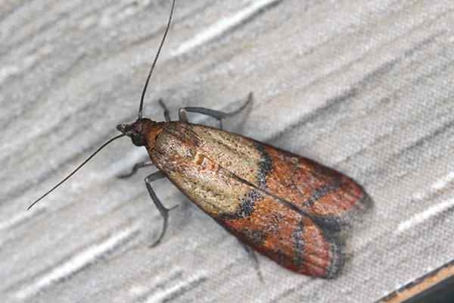How Indian Meal Moths Get Into Houston Pantries
Indian meal moths are some of the most common pests found in pantries and cupboards in homes across Texas and the southeast. While they are not considered dangerous, they can cause food contamination problems once they get into pantries and food stores, presenting huge problems for homes and businesses alike.
What Are Indian Meal Moths?
Indian meal moths are common household pests notorious for wreaking havoc in kitchens and pantries. They are small, reddish-brown moths with distinctive copper-colored wings that typically span about 5/8 inches. While they are largely considered harmless, as they are not known to bite humans nor spread disease, their larvae can cause significant problems within stored food products. Indian meal moth larvae infest grains, cereals, pasta, dried fruits, pet food, and other dried stored food, contaminating them with webbing and droppings. Their feeding can lead to spoiled food, economic losses, and even health concerns; consuming infested items can cause digestive issues.
With these factors in mind, we have developed this informative guide to help Houston homeowners protect themselves and their homes from Indian meal moths.
What Attracts Indian Meal Moths?
Indian meal moths are primarily attracted to food items that can be found inside pantries, especially stored dry foods such as:
Cereal
Rice
Pasta
Sugar
Flour
Crackers
Popcorn
Granola
Oatmeal
Chips
Rice cakes
Pet food
Beyond food items, they can also be attracted to dried plants, flowers, herbs, and spices. Food items that have been left out or crumbs on the floor can also attract Indian meal moths. Once inside a home, they are experts at getting into the pantry.
How Indian Meal Moths Get Inside
Once a few moths get inside a home, they can quickly breed into a severe infestation if they find a food source and a safe hiding place. As with any pest, that means that the best strategy for dealing with Indian meal moths is prevention. This makes it important to know how they get inside in the first place.
Most of the time, Indian meal moths are brought in accidentally when they are hidden away inside packaged food products that have already been infested. This means it’s vital that you check food items you bring into your home for signs of a pest infestation prior to bringing them inside.
The best way to recognize food that has been infested with Indian meal moths is to examine and feel its texture. If it is very clumpy, that usually means that moths have gotten into it and laid eggs. Once hatched, the larvae are webbed together inside the food item using strands of silk, giving the food its clumpiness.
Indian meal moths can also enter the home directly from the outside if you’ve left windows or doors open, or if your home has holes in walls and siding through which they could squeeze inside. Indian meal moths typically have a wingspan of just over half an inch, allowing them entry into all but the smallest gaps.
Indian Meal Moth Prevention
There are a number of steps you can take if you know you have (or think you have) Indian meal moths or other stored product pests in your home:
Do a thorough inspection of the home with a flashlight and magnifying glass to identify potential points of entry.
Check all dry food items in your home for signs of infestation.
Remove infested products from your home, putting them in an exterior garbage container.
Vacuum the home regularly to remove crumbs and loose food items that could attract them.
Sanitize cabinets, tables, and floors with hot water and general-use household cleaner.
Keep dry food items stored in sealed plastic containers.
If you’ve spotted Indian meal moths around your home or seen evidence of their presence, don’t hesitate to call a professional to have them safely and thoroughly removed.
At Modern Pest Control, we have been keeping Houston homes safe from Indian meal moths and other invasive pests for over half a century. If you’re suffering from a moth infestation or are worried that you could have one in the future, don’t hesitate to contact us today. Schedule your consultation and start your journey toward a pest-free home!

